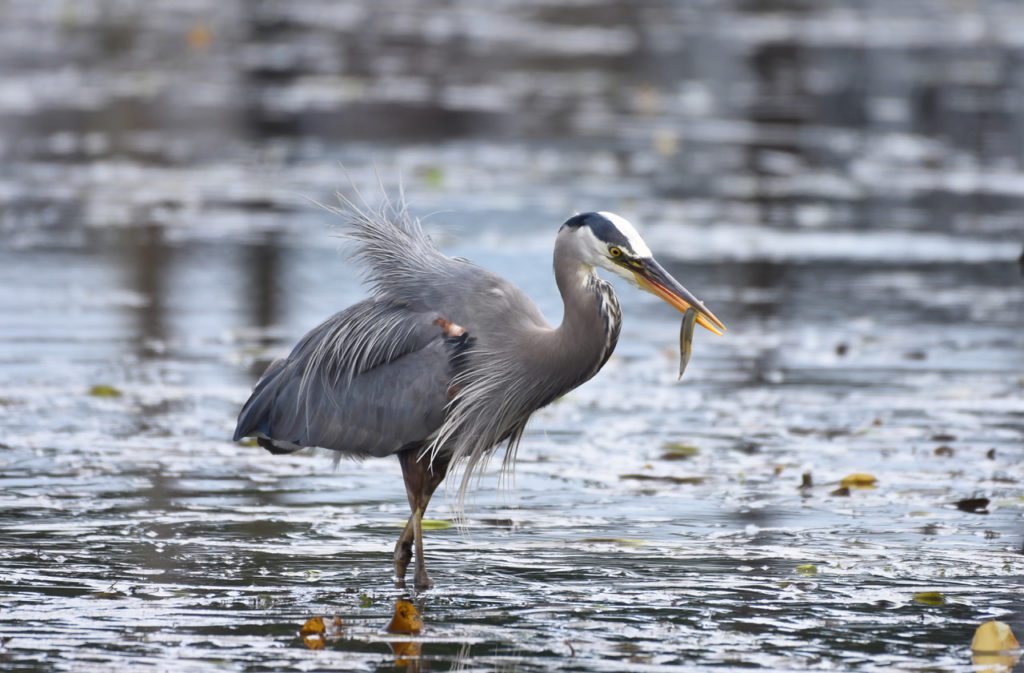
Salmon remains found in the scat of Pacific great blue herons nesting in British Columbia’s Salish Sea region put doctoral student Zackary Sherker on the track of a key predator of juvenile Chinook and coho salmon.
On the forest floor of heron rookeries abutting the Salish Sea, Sherker found thousands of Passive Integrated Transponder, or PIT, tags implanted by scientists in wild and hatchery juvenile Chinook and hatchery coho salmon.
The University of British Columbia graduate student had had no luck looking for evidence of salmon being preyed upon by the usual suspects: racoons, otters, kingfishers and mink.
Then one day he hitched a ride to seal haul-outs with a Cowichan Tribes biologist named Tim Kulchinksy. The pair spotted a group of herons foraging at the outflow of the river and Kulcinsky asked Sherker, “Did you ever look into herons?”
Using a magnetic device that activates PIT tags, Sherker went on to locate over the course of his study 1% of some 100,000 PIT tags implanted in juvenile salmon moving through the Cowichan, Big Qualicum and Capilano rivers. PIT tags are about the size of a grain of rice.
Sherker’s findings, published in The Canadian Journal of Zoology, are the first to estimate numbers of juvenile salmon being preyed on by understudied bird species in the Salish Sea.
Chinooks in particular are a high-value species whose dwindling numbers have prompted numerous research studies and efforts to increase stocks to more sustainable levels.
“I was most surprised to find that herons are foraging on smaller juveniles,” he said. “This is a bit of a shock because visual predators often target larger prey items.”
“Herons consumed an estimated 1-3 % of both wild and hatchery-reared juvenile salmon annually,” Sherker said. “Our study has quantified predation from 2008-2018 and annual predation rates were quite stable throughout,” he said. “The only thing to note was that predation spiked to an estimated 6% in a year of critically low water flow to the Cowichan in 2016, indicating that predation may intensify if spring freshets weaken in the wake of climate
change.”
The Pacific great blue heron, a wading bird weighing in on average under five pounds, is a stalk and strike hunter that locates its prey by sight during daylight hours. While they often breed in rookeries, they hunt alone. They also eat other fish, as well as frogs, and after the breeding season, they shift their behavior to forage extensively in farm fields, where they consume primarily small mammals like mice and voles, Sherker said.
The study analysis indicated that hatchery smolts could account for up to 10% of the heron chick diet during the rearing period. “It should be noted that the relatively small size of juvenile salmon compared to other heron prey items suggests that they may be a particularly important food source for chucks during early rearing, when young herons are gape-limited and at high risk of choking on larger fish prey,” he said.
Knowing where these young salmon are dying has become more critical as salmon stocks decline, the report said. Researchers feel that herons preying on smaller, weaker salmon may actually even be beneficial.
“Herons may be taking out fish that were destined to die somewhere else along the way, but were going to live long enough to compete with other fish for potentially limited resources in the early marine environment,” Sherker said. “This predation could benefit salmon stocks by weeding out the weak and allowing for less competition and higher growth among other fish in these critical juvenile life stages.”
The findings suggest that heron rookeries near rivers ought to be monitored and that heron predation on salmon should be taken into account in future salmon recovery plans.
Collaborators on the study included the British Columbia Conservation Foundation and Cowichan Tribes, with funding from the Pacific Salmon Foundation.





